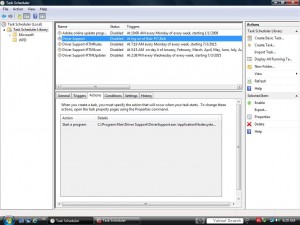Driver Support Has Stopped Working
Published by John on January 5, 2016 Under Computer Repair Recently, while fixing a clients computer, I ran into an issue uninstalling Driver Support. Driver Support is one of those pesky pieces of Malware that many(most?) antivirus’s like Norton, AVG, and Mcafee will happily let you install on your computer.
Recently, while fixing a clients computer, I ran into an issue uninstalling Driver Support. Driver Support is one of those pesky pieces of Malware that many(most?) antivirus’s like Norton, AVG, and Mcafee will happily let you install on your computer.
Driver Support’s stated purpose is to identify/find missing or bad drivers, optimize your computer, and resolve issues with your PC. However, it is really falls into the malware/adware/scareware category of software, reports non-issues with your PC in an attempt to get you to buy their full version. It is one of those programs people find when they are trying to install a new wireless card or do a pc tuneup, which inevitably doesn’t actually help.
After uninstalling Driver Support, everytime I started windows, I got a ‘Driver Support Has Stopped Working Error.’ In the Windows Event Viewer, an Application error was generated referencing Driversupport.exe, which of course should be completely removed after unsintalling if it were a legitimate program…except it is Malware, so it doesn’t actually uninstall itself.
Fixing the Driver Support Has Stopped Working Error Message
As is often the case with Malware, the place to check is your scheduled tasks.
- Open up Windows Scheduled Tasks viewer by typing Task Scheduler into your start menu.
- Look through the Task Scheduler Library and disable the Driver Support Tasks. On this computer, there were four, including: Driver Support, Driver Support-RTMRules, Driver Support-RTMScan, and Driver Support-RTMUpdater
- Next, check the actions section of the Driver Support tasks to find what files it is attempting to load. In this case, c:\Program Files\Driver Support\Driver Support.exe was scheduled to run everytime a user logged in, as well as periodically throughout the month.
- Delete these files and the Driver Support Malware should stop trying to load every time your computer starts. You can also delete the scareware tasks.
7 Comments |

Comments:
I purchased drive support 1 sept 2016 had to do a recovery on computer?
I would recommend trying to get a refund and if this is not possible, contact your bank and do a charge back.
Driver support is an adware/ransomware/malware program, setup to make you think your computer has problems and it can fix them. The end result is they are trying to get you to pay them for a program that really doesn’t offer any value.
Instead if you are having issues, try to find a local computer repair company that can work with you on your issues. When you find a good one, they will offer much more value than Driver Support does and actually help you, rather than try to extort you like Driver Support does.
Thanks for this. Have had same issue when I was trying to bring an ancient laptop (10yo) back to life. Downloaded Driver Support in Aug 15, still didn’t work properly; rang the help number and became suspicious when a bloke in America (I’m in Australia) claimed he could see all sorts of problems with my computer, wanted to take charge of it remotely and claimed it would take some days to fix. I declined his exceptionally kind offer and also decided not to accept his offer of a refund as I thought the less I had to do with them the better. Uninstalled it (or so I thought), but have continued to get the message above.
The laptop subsequently downloaded hundreds of updates and eventually started running beautifully all by itself and has continued to do so ever since until today when it wouldn’t start. Got it going again with total removal of battery, etc but prompted me to started looking into Dr Support to see if it could have caused any problems. Found your instructions above and have just followed your steps and found exactly the same set of scheduled tasks. Hopefully that’s the end of it.
Have one remaining concern – I found a few emails from Dr Supp that I’d previously ignored, telling me I hadn’t activated it and urging me to ring them. Do you know if there’s anything I can do to shut those down? One was quite recent. I’m not keen to start up any kind of contact with them.
Thanks very much for your helpful article.
Cheers, Jane
Jane, that is often how these sorts of ransomeware scams work, including the fake Microsoft calls.
They take over the computer remotely and run some simple commands that show normal computer activity, but can look scary to someone that has never seen them before. Then, they tell you your computer is infected or broken and try to get you to send them $300. Another red flag is that they often don’t take credit cards, but instead try to get you to pay with a money order or some other payment method that can not be refunded.
Regarding your question, you can ignore them, but depending on how much money you paid, you may want to seek a refund or chargeback at your bank.
Thanks John, I paid about $40 so think I got off lightly by not progressing any further than I did (didn’t allow remote control, etc). I really don’t want to start up communication with them again to get the refund (giving bank details, etc) or to tell them to stop the emails, so guess I’ll have to keep ignoring them and hopefully they’ll give up after a while!
There are a lot of traps out there! Thanks for your previous article – have not had any more ‘…stopped working’ messages since deleting the Task sched files.
Thanks again and cheers
Jane
Brilliant. Easy to follow clear walkthrough. It’s not that the error message was causing a great hardship. It’s just so anoying that there are so many schysters out there trying to squeeze money out of us consumers for no good reason. It just feels good to delete their handiwork. Thank you.
Thank you for posting this fix!!! It has been very helpful in getting rid of that annoying warning.
Add a Comment